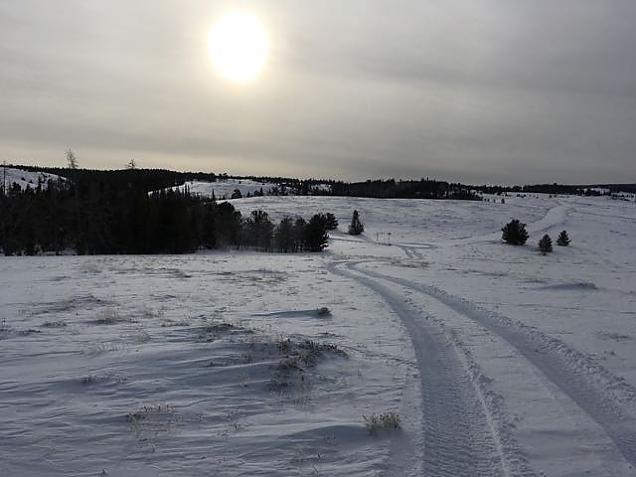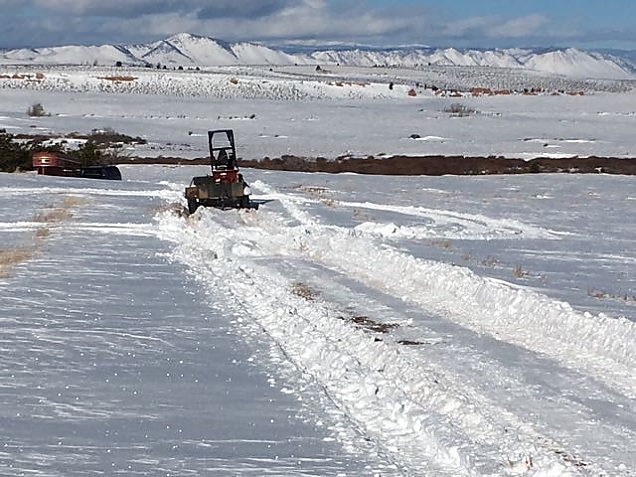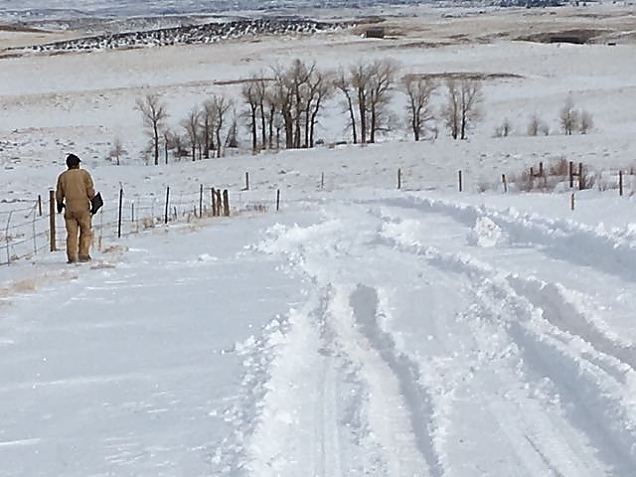It has been a couple of very busy days for us, and we've really put the Polaris Ranger to work. The cause of all the work is snow.

Early morning view of our improvised road to the cabin site.
It started with a scratchy phone call from one of the three couples that are living up here year 'round. They've been here for 8 or 9 years and know the seasons and the struggles well. And, even they have been caught off guard by the weather. The amount of snow, along with some freezing rain, and no chinook winds have really made a mess of the roads. They had been out with their Ranger and got stuck. They had not yet put the tracks on, and ended up in deep snow on the county road. They were able to walk to their house that day, and the next day hiked back to dig out. But, things did not go well and the Ranger ended up buried in a drainage ditch.
That can happen easily enough. A tire, usually a rear tire, drops off the side of the road, even an inch or two, and efforts to get back on the road surface just spin wheels and pull you further into the low spot. Pretty soon, gravity gets you and pulls you to the lowest spot.
Anyway, I was able to figure out where they were and that they needed help, so fired up our Ranger and took off. Lynne and I drove out Wapiti to County Road 89 and then south a bit to find them. Yup, they were buried and weren't going anywhere without help. They had done a great job of digging all the snow from around the vehicle, so all we needed to do was pull them out. I turned our Ranger around and used the winch. It worked great and pretty soon they were back on solid ground. But, the amount of snow meant they'd just get stuck again trying to drive home. So, I turned around, hooked up a tow rope, and then assisted them home. They could have driven most of it unaided, but when they did start to slip or get stuck, my constant pulling kept them moving.
The next day, our neighbor and I decided to try to open up the county road going north toward the state line. Usually, the wind has blown most of the road dry and there are just 2 or 3 places that need to have drifts removed. Not the story this time. There was enough snow in places that the truck could get stuck. If the snow gets deep enough that it starts to scrape the bottom of the truck, or gets up to the running boards, then not even snow chains are going to keep you moving for long.

Snow blower on a trailer, stuck in deep snow. You can see that I'm plowing a path to it.
We used a combination of the snow plow on the Ranger, and a snow blower to clear the road. We'd do sections of 100 yards or so. First, I make a run with the plow, staying as far as I dare to the leeward side of the road, piling the snow on the opposite side of the prevalent wind direction so that the pile does not create a "snow fence" and just make things worse for the next storm. Then, coming back, I'd widen the track, again moving the snow to the leeward side, but leaving a row of snow down the middle of the road. A third run then moved that pile out of the middle of the road.
You'd think that would be it. But, no. Turns out, the Ranger, with tracks on, tends to ride on the top of the snow and not fall down through it. That is the beauty of the tracks and the reason we want them and trust them to get us anywhere we need to go, even in deep snow. So, even if I move a large amount of snow on those first three passes, there can still be a lot of snow. The best way forward is to continue the runs up and down the road, only now always moving the snow to the center of the road where my neighbor then drives along with a snow blower blowing the snow well off the road. Multiple passes with this strategy may work?

The road after a couple of passes witht he plow. The snow is still 12" or more deep at this point.
Except in those spots where someone has gotten stuck and dug themselves out, leaving piles of compacted snow in the middle of the road. Or, in places where the snow has drifted badly, then frozen due to the unusual freezing rains we had a few nights ago. In these spots, we tend to leave "humps" of snow that can be a foot or more deep. I can eventually knock them down by hitting them over and again with the plow, taking a few inches off each time.
We did all the above for about 7 hours on Saturday. We made good progress, but I am not sure we could get through with the trucks yet. We did drive the full route we need to take with the trucks, and I continued to move snow off the road where we could do it in 2 passes, but I suspect we'll need to put in many hours again today to feel comfortable driving out.
The good news is that the neighbors who got stuck the other day now have tracks on their Ranger, and are driving it to the state line where they have a truck parked. And, I'm taking Lynne up to meet them and accompany them to town! She had a relatively short shopping list because we really are pretty well provisioned, but she will definitely get a couple of boxes of wine! And, check the mail. It has been 2 weeks!
The commodity I'm starting to worry about now is gasoline. I'm down to 6 gallons for the Ranger and the snow blower. I'll go through that today, I'm sure. So, our efforts to get out today need to be successful.
As a lesson learned, I think we should also keep one of our trucks at the state line. After all, the Expedition is sitting here next to the cabin, stranded and of no use to us where it is. (Digging out the driveway and Hidden Meadows Lane is the next chore, but I'll need gasoline to do that.)
Update: After I drafted the above, we decided it was simply not possible to use the plow on the Ranger to move the deepest snow, especially since it is now very compacted and icy. One lesson learned is to never drive the Ranger with tracks over any place that you want to later use a snow blower. After busting the snow blower (track came off), and realizing the Ranger just does not have the ability to plow heavy, frozen, deep snow, we need to find a different solution. Stay tuned.
